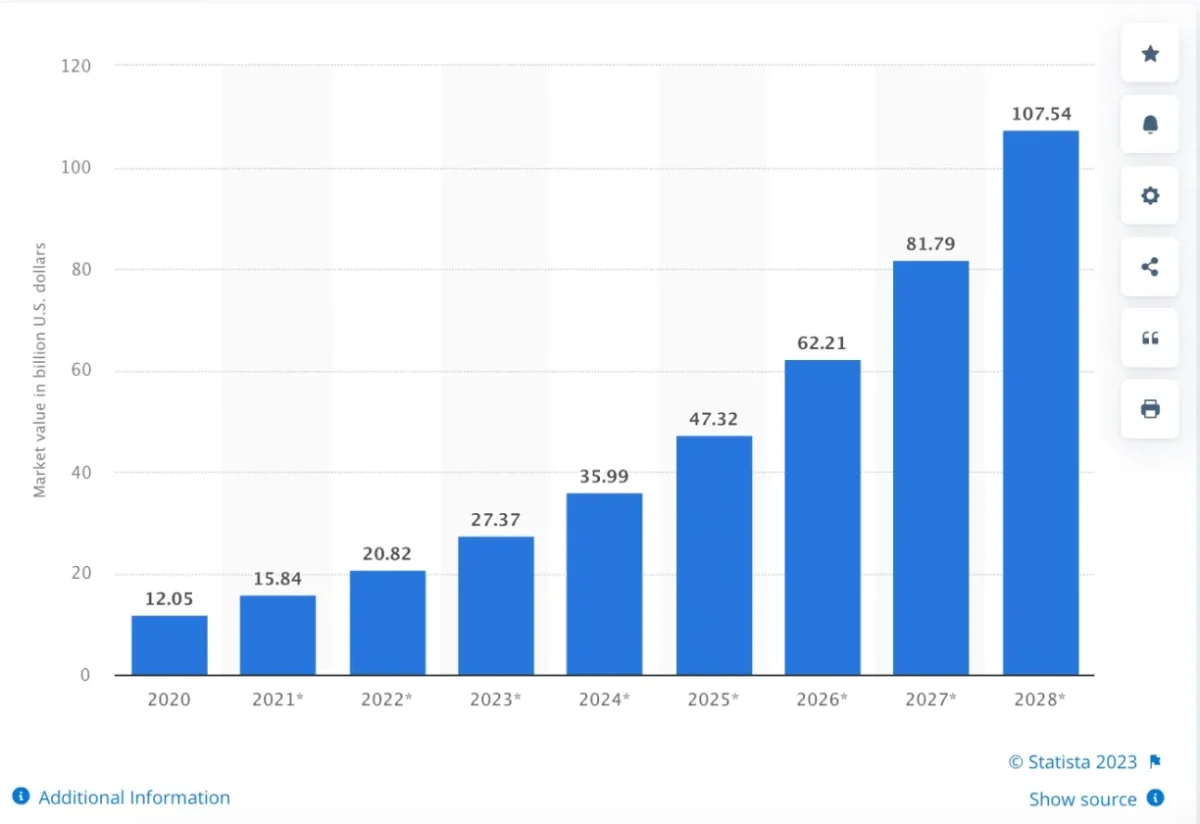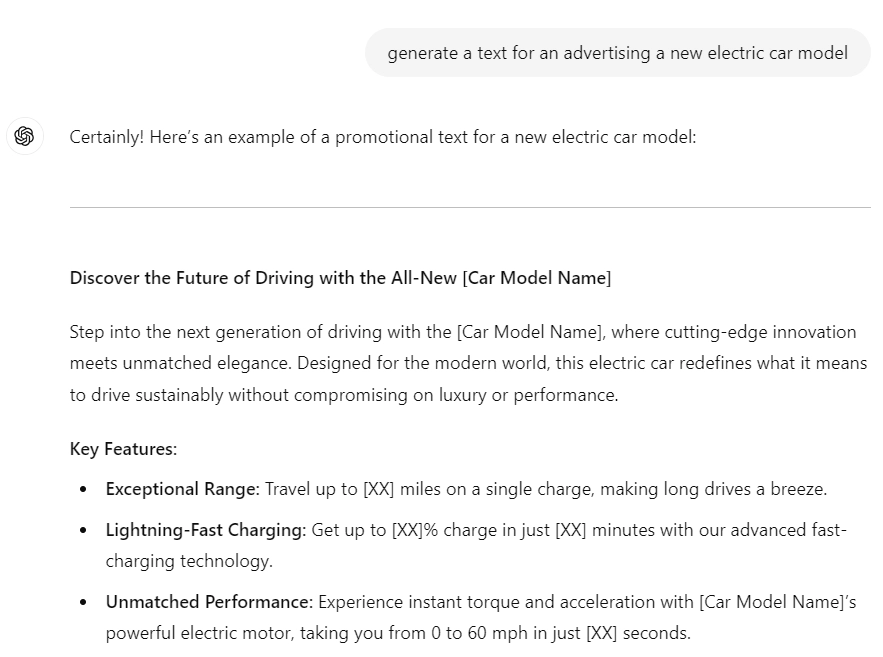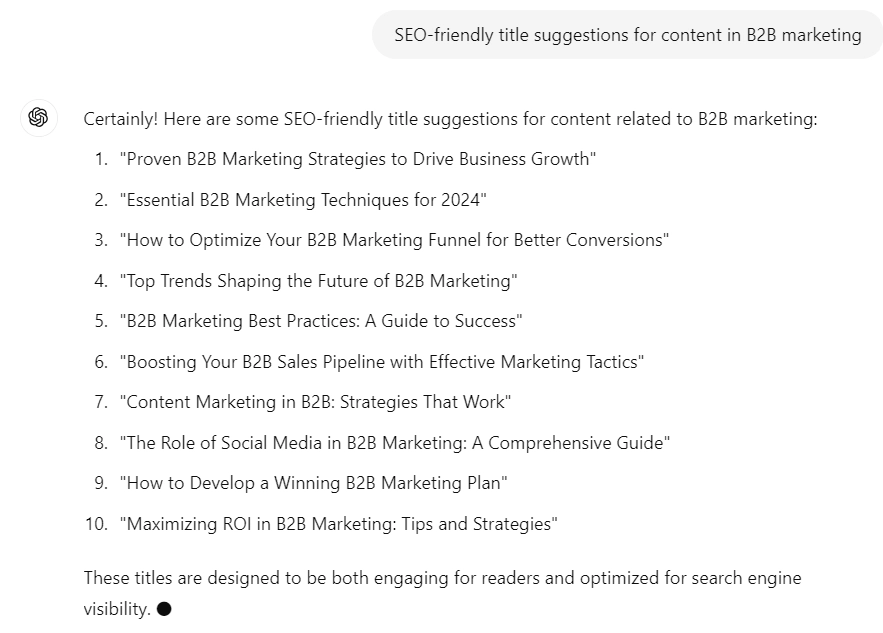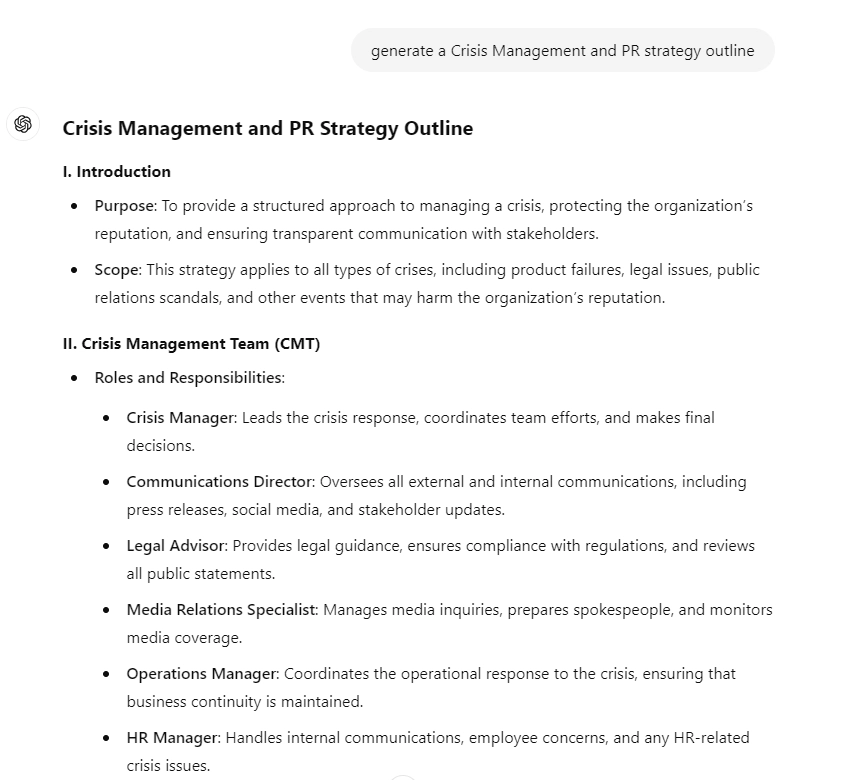The share of artificial intelligence in the marketing industry is rapidly increasing (see Figure 1). However, the use of relatively new tools, such as generative AI and, in particular, ChatGPT in marketing is not widely known.
However, according to McKinsey Research, 90% of commercial leaders plan to adopt generative AI solutions in the next two years.1
Figure 1. The market value of artificial intelligence (AI) in marketing worldwide from 2020 to 2028

20 Use cases of ChatGPT in marketing
1. Content ideation
Content ideation is a critical phase in content marketing, and ChatGPT serves as a valuable tool for generating innovative and relevant ideas. It excels at topic suggestions, brainstorming trending or niche subjects tailored to the target audience and industry, ensuring that the content aligns with audience interests and market demands.
ChatGPT helps plan and organize publishing schedules by assisting in creating content calendars, enabling consistent output and better time management. For headline generation, it crafts catchy and clickable headlines for blogs, articles, or other content formats, boosting click-through rates and reader engagement.
Additionally, ChatGPT supports marketers by offering event campaign ideas and developing creative and impactful content concepts for events, holidays, or trending topics.
2. Audience research
Audience research is collecting and analyzing data about your target audience to gain a deeper understanding of their interests, preferences, behaviors, and needs.
ChatGPT can be used to analyze customer data, such as analyzing:
- 1- Search engine queries using the output of tools like Google Trends to identify trends
- 2- Internal search queries on the company’s website
- 3- Social media interactions of existing or potential users
- 4- Past purchases to identify patterns and trends in customer behavior.
ChatGPT can analyze customer data, such as browsing behavior, purchase history, and feedback, to uncover insights about your audience’s preferences, interests, and pain points. These insights can inform more effective marketing messages, content strategies, and product development decisions.
Please note that the data must be fed into ChatGPT as files in formats such as CSV or JSON.
3. Content creation
Content creation, particularly text generation, can be a powerful tool for marketing when using ChatGPT. These AI-generated texts can be used for a variety of purposes other than generating ideas, such as:
- Content creation for content marketing in the form of emails, social media posts, blog articles, etc.
- Script writing and storytelling for advertising goods and services (see Figure 2)
4. Copywriting for the company blog
Figure 2. An example of AI-generated content for advertising a new electric car model by using ChatGPT in marketing campaigns

Content generated by ChatGPT can be integrated with other marketing strategies and channels like:
- Preparing posts for social media platforms
- Generating personalized, attractive, and persuasive emails for email marketing.
5. Ad Copywriting
Writing compelling ad copy is essential for capturing attention and driving conversions. ChatGPT in marketing can generate ad copy for various platforms, including Google Ads, Facebook, and LinkedIn, ensuring that the messaging is engaging and aligned with the target audience. It can also help in A/B testing by creating different versions of ads to see which performs best.
- Google Ads: ChatGPT can craft compelling ad copy for Google Ads campaigns, including headlines, descriptions, and display URLs.
- Social Media Ads: It can generate creative ad copy tailored to specific audiences for platforms like Facebook, Instagram, LinkedIn, and TikTok.
- Native Advertising: Marketers can utilize ChatGPT to craft native ad content that seamlessly integrates with the surrounding content’s look and feel, thereby enhancing click-through rates.
6. Writing product descriptions
Product descriptions are crucial to marketing, as they provide potential customers with information about a product’s features, benefits, and value. Integrating ChatGPT into your marketing efforts can support creating engaging, informative product descriptions that speak directly to the needs and interests of your target audience.
7. Content repurposing
Content repurposing allows marketers to maximize the value of existing content by adapting it for various formats and audiences, and ChatGPT makes this process seamless:
- E-books from Articles: Multiple articles can be combined and expanded into e-books, offering in-depth resources for lead generation and audience education.
- Summarizing Content: ChatGPT transforms long-form content, such as webinars or podcasts, into concise blog posts, social media snippets, or brief summaries, ensuring accessibility for diverse audiences.
- Blogs to Newsletters: It repackages blog content into compelling email newsletters, enabling businesses to maintain consistent engagement with subscribers without creating new content from scratch.
- Webinar and Video Highlights: ChatGPT extracts key points and actionable insights from webinars or recorded videos, creating promotional material or highlight reels that drive further audience interest.
- Social Media Posts: It reformats detailed articles or reports into digestible, shareable posts optimized for platforms like Instagram, Twitter, and LinkedIn.
8. SEO optimization
Leveraging ChatGPT in marketing efforts can be effective in terms of SEO. SEO, or search engine optimization, involves optimizing your website and content to rank higher in search engine results pages (SERPs) for relevant keywords and phrases. ChatGPT can help in these areas:
- Generate attractive topic ideas for content marketing
- Make keyword research
- Find the right and attractive titles
- Group search intent
- Create content structure
- Generate meta descriptions
Figure 3. ChatGPT-generated, SEO-friendly title ideas

For more: AI in SEO.
9. Chatbot for lead generation & customer support
ChatGPT can be integrated into a chatbot to provide instant and personalized customer support, turning it into a virtual assistant. Chatbots can help customers with
- Answer frequently asked questions
- Provide product information
- Provide technical support (e.g. during the checkout process)
- Troubleshoot issues.
Chatbots in marketing can help:
- Improve customer satisfaction
- Reduce response times
- Decrease the workload of customer service representatives.
In addition, ChatGPT can support conversational lead generation: By integrating ChatGPT into chat widgets on websites, marketers can capture leads through natural conversations and guide users down the funnel.
10. Creating customer surveys
Surveys are an effective way to gather feedback and insights from customers, which can help marketers improve their products, services, and marketing strategies.
11. Question generation
12. Organizing survey structure
- Making surveys multilingual with its translation ability
- Survey analysis
Other use cases of ChatGPT in VoC include Interactive Campaigns. ChatGPT can power interactive campaigns, like quizzes and conversational polls, that engage users and gather data for personalization.
Data Analysis and Reporting
ChatGPT can automate the generation of marketing reports by analyzing data from various sources such as Google Analytics, social media platforms, and email campaigns. It can provide insights into what’s working and what needs improvement, helping marketers make data-driven decisions.
13. Performance Reporting
ChatGPT can help generate reports by analyzing campaign performance metrics and suggesting actionable insights.
14. Data Interpretation
It can assist in interpreting complex data sets and translating them into easily understandable insights for marketing teams.
15. Predictive Analytics Support
By interpreting historical data, ChatGPT can aid in predictive analytics, helping marketers forecast outcomes and make data-driven decisions.
Crisis Management and PR
In the event of a PR crisis, ChatGPT can generate timely and appropriate responses to manage the situation effectively. It can help draft public statements, social media posts, and internal communications, ensuring that the messaging is consistent and aligned with the brand’s values.
16. Crisis Response Drafting
In times of crisis, ChatGPT can quickly draft initial responses, statements, and FAQs to help manage public relations.
17. Reputation Management
It can monitor and respond to online mentions, reviews, and social media posts, helping brands manage their reputation proactively.
18. Press Release Creation
ChatGPT can draft press releases that effectively communicate key messages to the media, ensuring timely and accurate dissemination of information.

19. Educational content
Educational content is a powerful tool for building authority and trust, and ChatGPT streamlines its creation with the following use cases:
- E-books and Whitepapers: ChatGPT develops guides or in-depth reports tailored to specific industries or audiences, serving as valuable resources for lead generation and brand credibility.
- FAQs and How-To Guides: It creates clear and actionable FAQs or step-by-step guides that address common customer questions and problems, enhancing user experience and reducing support requests.
- Case Studies: ChatGPT in marketing drafts engaging case studies that showcase real-world success stories or practical applications of a company’s products or services, demonstrating value and building trust among potential customers.
FAQ
How can ChatGPT improve customer engagement?
ChatGPT enhances customer engagement by providing immediate and personalized responses through AI chatbots. These bots can handle common customer queries 24/7, reduce response times, and provide recommendations based on user behavior. Businesses can improve satisfaction and foster brand loyalty by engaging customers in real-time.
Can ChatGPT help with content creation?
Yes, ChatGPT can write diverse content types, including blogs, social media posts, articles, ad copy, and newsletters. Marketers can input prompts, and ChatGPT in marketing generates relevant, high-quality content that saves time. It can also adapt tone and style based on brand guidelines, ensuring content consistency across channels.
Is ChatGPT useful for personalized marketing?
ChatGPT in marketing can analyze customer data, like past interactions, preferences, and behavior, to craft personalized and highly targeted messages that resonate with specific audiences. For example, it can tailor email campaigns with personalized product recommendations, offers, or discounts, leading to increased open rates, click-throughs, and conversions.
What are the benefits of using ChatGPT for customer feedback analysis?
ChatGPT in marketing can process large volumes of customer feedback from surveys, reviews, and social media mentions. Identifying recurring issues, positive feedback, and potential improvements helps businesses refine their products and services. ChatGPT’s ability to analyze sentiment and detect patterns can lead to actionable insights that enhance customer satisfaction.
Further reading
Learn more on ChatGPT to understand LLMs better by reading:
- ChatGPT Education Use Cases, Benefits & Challenges
- How to Use ChatGPT for Business: Top 40 Applications
- GPT-4: In-depth Guide
External Links
- 1. Marketing and sales soar with generative AI | McKinsey. McKinsey & Company

Comments
Your email address will not be published. All fields are required.